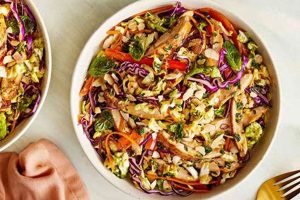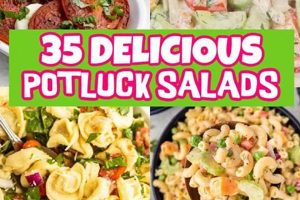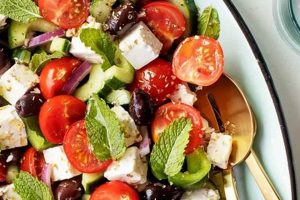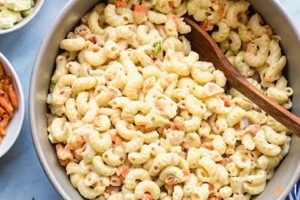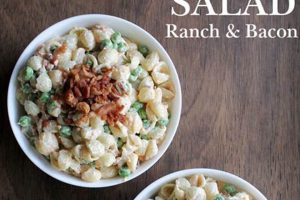A hearty, protein-rich salad typically includes beans, corn, tomatoes, bell peppers, avocado, and grilled or shredded meat such as steak or chicken. Variations may incorporate other ingredients like cheese, onions, cilantro, and a vinaigrette-style dressing often featuring lime juice or southwest spices. An example might feature black beans, grilled corn kernels, diced tomatoes, chopped bell peppers, avocado slices, shredded grilled chicken, cheddar cheese, and a cilantro-lime dressing.
These salads offer a nutritionally balanced meal option combining fresh produce with lean protein. Their adaptability makes them suitable for various dietary needs and preferences, with the potential to substitute ingredients or adjust portion sizes. Historically linked to chuck wagon meals and the practicality of combining readily available ingredients, these robust salads now enjoy widespread popularity as a satisfying and flavorful dish.
The following sections will explore various ingredient combinations, dressing options, and tips for creating a delicious and customized version of this classic salad.
Tips for Crafting the Perfect Cowboy Salad
Achieving a well-balanced and flavorful salad requires attention to ingredient selection, preparation techniques, and dressing choices. The following tips offer guidance for creating a satisfying and customizable culinary experience.
Tip 1: Grill Ingredients for Enhanced Flavor: Grilling vegetables like corn, bell peppers, and onions adds a smoky char and depth of flavor. Consider grilling the protein as well for a more robust taste.
Tip 2: Balance Fresh and Hearty Ingredients: Combine a variety of textures and flavors by incorporating crunchy vegetables, creamy avocado, and substantial protein sources. This balance ensures a more satisfying meal.
Tip 3: Choose a Complementary Dressing: A vibrant vinaigrette complements the salad’s ingredients without overpowering them. Cilantro-lime, chipotle-ranch, or honey-mustard dressings are excellent choices.
Tip 4: Don’t Overcrowd the Salad: Allow each ingredient to shine by avoiding overcrowding. This also ensures even distribution of the dressing.
Tip 5: Consider Ingredient Seasonality: Using fresh, seasonal produce enhances the salad’s flavor and nutritional value. Adapt ingredient choices based on availability.
Tip 6: Customize to Dietary Needs: This salad adapts easily to various dietary preferences. Substitute plant-based protein sources or omit cheese for vegan or dairy-free versions.
Tip 7: Proper Storage Maintains Freshness: Store leftover salad components separately and combine just before serving to maintain optimal freshness and prevent sogginess.
By following these guidelines, one can consistently create a delicious and personalized salad experience.
Crafting a well-executed salad offers both nutritional benefits and culinary satisfaction. These tips highlight key considerations for elevating a simple combination of ingredients into a truly exceptional dish.
1. Hearty Ingredients
Hearty ingredients form the foundation of a satisfying cowboy salad. These components provide substance and texture, contributing to the salad’s ability to serve as a complete meal. Beans, corn, and potatoes are prime examples, offering complex carbohydrates and dietary fiber. Their inclusion ensures a robust and fulfilling culinary experience, aligning with the historical context of the salad as a substantial meal for cowboys on the range. The interplay of these ingredients contributes to the salad’s overall nutritional value and textural appeal.
Consider the role of black beans. They provide a rich source of protein and fiber, contributing to satiety and digestive health. Corn, whether grilled or off-the-cob, offers a contrasting sweetness and textural element. Roasted sweet potatoes, while less traditional, can add another layer of heartiness and nutritional complexity. The strategic combination of these ingredients creates a balanced and satisfying meal, distinguishing a cowboy salad from lighter fare. One might find variations incorporating barley or quinoa for added nutritional density and texture.
Understanding the role of hearty ingredients provides a framework for crafting a well-balanced and satisfying cowboy salad. This focus on substance and texture differentiates the salad from lighter options, aligning with its historical origins and modern interpretations. Selecting a variety of hearty ingredients contributes to both the salad’s nutritional value and its overall appeal as a flavorful and fulfilling meal.
2. Protein Focus
Protein plays a crucial role in cowboy salad recipes, contributing significantly to their status as a substantial and satisfying meal. Historically, these salads served as a primary source of sustenance for cowboys working long hours on the range, necessitating a high protein content to fuel their demanding lifestyle. This focus on protein remains a defining characteristic, differentiating cowboy salads from lighter, vegetable-centric salads. Grilled or shredded beef, chicken, or pork are common choices, providing essential amino acids and contributing to a feeling of fullness. The protein component not only enhances the salad’s nutritional value but also adds depth of flavor and textural complexity. For example, grilled steak provides a rich, savory element, while shredded chicken offers a milder, more versatile base. Even crumbled bacon or chorizo can be incorporated to add a smoky, salty dimension.
Beyond traditional meat options, contemporary interpretations often incorporate alternative protein sources. Black beans, lentils, or chickpeas offer plant-based alternatives, aligning with vegetarian or vegan dietary preferences while maintaining the protein focus. These additions contribute fiber and other essential nutrients, further enhancing the salad’s nutritional profile. The adaptability of cowboy salad recipes allows for a wide range of protein choices, catering to diverse tastes and dietary needs. For instance, a salad featuring grilled salmon provides a heart-healthy protein option with a distinct flavor profile. The choice of protein influences not only the nutritional value but also the overall culinary experience.
Selecting the appropriate protein source is crucial for achieving a well-balanced and flavorful cowboy salad. The historical context emphasizes the importance of protein as a source of sustained energy and satiety. Modern adaptations continue to prioritize protein, offering a wide array of choices to meet diverse dietary needs and preferences. Understanding this emphasis on protein allows for informed choices, whether opting for traditional meats, plant-based alternatives, or other innovative protein sources. This ensures the salad remains a nutritionally complete and satisfying meal, aligning with its historical purpose and contemporary appeal.
3. Fresh Produce
Fresh produce plays a vital role in cowboy salad recipes, contributing not only to nutritional value but also to flavor, texture, and overall appeal. While historically limited by seasonal availability and accessibility on the range, fresh ingredients like tomatoes, onions, bell peppers, and corn were essential components, providing vitamins, minerals, and a refreshing counterpoint to the richness of the protein and other hearty elements. This emphasis on fresh produce continues in contemporary adaptations, with expanded options reflecting broader ingredient availability and culinary preferences. The incorporation of fresh ingredients elevates the salad from a simple combination of components to a vibrant and flavorful culinary experience. For instance, ripe tomatoes contribute juiciness and acidity, while crisp bell peppers offer a contrasting crunch and subtle sweetness. The careful selection and preparation of fresh produce enhances the overall balance and complexity of the salad.
The quality and variety of fresh produce significantly impact the final product. Locally sourced, seasonal ingredients often offer superior flavor and nutritional content. Farmers’ markets or personal gardens can provide access to peak-season produce, maximizing the salad’s freshness and vibrancy. Furthermore, incorporating a diverse range of colorful vegetables enhances both the visual appeal and the nutritional profile. For example, the inclusion of dark leafy greens like spinach or romaine lettuce adds a boost of vitamins and antioxidants, while brightly colored bell peppers contribute vitamin C and other essential nutrients. The thoughtful combination of various fresh produce elements ensures a nutritionally balanced and aesthetically pleasing meal.
Prioritizing fresh produce in cowboy salad recipes yields numerous benefits, including enhanced flavor, improved nutritional value, and increased culinary appeal. While historical limitations influenced ingredient choices, contemporary adaptations embrace a wider range of fresh components, reflecting evolving culinary trends and greater access to diverse produce. Careful selection, proper handling, and creative combinations of fresh ingredients elevate the cowboy salad from a simple dish to a vibrant and satisfying culinary experience. Understanding the importance of fresh produce within this context allows for the creation of flavorful and nutritionally balanced meals, reflecting both the historical origins and the ongoing evolution of this classic dish.
4. Flavorful Dressings
Flavorful dressings are essential to cowboy salad recipes, acting as a unifying element that complements and enhances the diverse ingredients. A well-chosen dressing provides a cohesive flavor profile, balancing the heartiness of beans and proteins with the freshness of vegetables. The dressing not only adds flavor but also contributes to the overall texture and moisture content of the salad. Historically, simple vinaigrettes made with readily available ingredients like vinegar and oil were common. Contemporary versions often incorporate a broader range of flavors, drawing inspiration from Southwestern cuisine and utilizing ingredients such as lime juice, cilantro, chipotle peppers, and cumin. For example, a cilantro-lime vinaigrette provides a bright, citrusy counterpoint to the richness of grilled steak and black beans, while a creamy chipotle-ranch dressing adds a smoky, spicy dimension. The dressings role extends beyond mere flavor enhancement; it contributes to the overall sensory experience of the salad.
The choice of dressing can significantly impact the overall balance and enjoyment of a cowboy salad. A heavy, creamy dressing might overwhelm the fresh vegetables, while a bland dressing could fail to complement the robust flavors of the other ingredients. The ideal dressing complements the chosen ingredients, enhancing their individual characteristics without overpowering them. Consider a salad featuring grilled chicken, corn, black beans, and avocado. A light vinaigrette with lime and cilantro would highlight the fresh flavors of the produce, while a heavier dressing might mask their subtleties. Understanding the interplay between the dressing and other ingredients allows for informed choices, resulting in a more harmonious and flavorful salad. Furthermore, the dressing can be adjusted to accommodate dietary preferences or restrictions. A simple olive oil and vinegar base can be easily adapted with herbs, spices, or a touch of sweetness to create a variety of flavor profiles without relying on processed ingredients.
Flavorful dressings are integral to the success of cowboy salad recipes, playing a crucial role in unifying the diverse ingredients and creating a cohesive culinary experience. The dressing choice should consider the specific components of the salad, aiming for a balanced and harmonious flavor profile. Understanding the interplay of flavors and textures allows for informed decisions regarding dressing selection and customization, ensuring a satisfying and flavorful salad. From simple vinaigrettes to more complex creations, the right dressing elevates the cowboy salad from a collection of ingredients to a well-integrated and enjoyable meal.
5. Adaptable Components
Adaptability stands as a defining characteristic of cowboy salad recipes. This inherent flexibility stems from the historical context of these salads, which were often assembled using readily available ingredients on the chuck wagon. This pragmatic approach necessitated substitutions based on scarcity or seasonal availability, fostering a tradition of adaptability that persists in contemporary interpretations. The practical implications of this adaptability are significant, allowing for customization based on dietary restrictions, personal preferences, and ingredient accessibility. For example, individuals following a vegetarian diet can substitute beans or lentils for traditional meat proteins, maintaining the salad’s heartiness and nutritional value. Similarly, seasonal variations can be embraced by incorporating readily available produce, such as swapping winter squash for summer tomatoes. This adaptability ensures the cowboy salad remains a versatile and accessible meal option, regardless of dietary constraints or ingredient limitations.
The adaptability of cowboy salad recipes extends beyond ingredient substitution. Portion sizes can be adjusted to accommodate individual needs, ranging from light lunches to substantial dinners. The salad’s modular nature also lends itself to creative interpretations, allowing for the incorporation of regional or cultural influences. For instance, a Southwestern-inspired version might include roasted corn, black beans, and a chipotle-lime dressing, while a Mediterranean adaptation could incorporate olives, feta cheese, and a lemon-herb vinaigrette. This flexibility fosters culinary creativity, transforming the cowboy salad from a fixed recipe into a customizable template for flavorful and personalized meals. Furthermore, adaptability simplifies meal planning, allowing individuals to utilize leftover ingredients or incorporate readily available pantry staples. This inherent practicality contributes to the enduring popularity of cowboy salads, offering a convenient and adaptable meal solution.
The adaptability inherent in cowboy salad recipes is a key attribute contributing to their continued relevance and appeal. This flexibility, rooted in the practicalities of chuck wagon cooking, allows for customization based on individual needs, preferences, and available resources. From ingredient substitutions to portion adjustments and creative flavor combinations, the adaptability of cowboy salads ensures their versatility as a meal option. This characteristic not only simplifies meal planning but also encourages culinary exploration, empowering individuals to create personalized versions of this classic dish while honoring its historical origins and adaptable nature.
6. Easy Preparation
Ease of preparation is a hallmark of cowboy salad recipes, reflecting their historical origins as a practical meal for cowboys on the open range. Limited resources and time constraints necessitated simple cooking methods and minimal preparation. This practicality continues to resonate in modern adaptations, making cowboy salads a convenient and accessible meal option for busy individuals. The inherent simplicity of the recipe allows for quick assembly, utilizing readily available ingredients and requiring minimal cooking expertise. For example, pre-cooked or leftover grilled chicken can be combined with canned beans, pre-cut vegetables, and a simple vinaigrette, resulting in a nutritious and flavorful meal with minimal effort. The emphasis on easy preparation ensures that cowboy salads remain a practical and time-efficient meal choice.
The ease of preparation extends beyond the basic recipe. The adaptable nature of cowboy salads allows for further simplification through meal prepping or batch cooking. Components such as grilled proteins, chopped vegetables, and dressings can be prepared in advance and stored separately, allowing for quick assembly throughout the week. This approach not only saves time but also reduces food waste by utilizing leftover ingredients. Furthermore, the simplicity of the recipe makes it ideal for large gatherings or potlucks. The salad can be easily scaled to accommodate larger groups, and its adaptable nature allows for customization to suit diverse tastes. The practical benefits of easy preparation contribute to the enduring popularity of cowboy salads as a convenient and versatile meal option.
The connection between easy preparation and cowboy salad recipes is fundamental to the dish’s identity. Rooted in the practicalities of chuck wagon cooking, this emphasis on simplicity and efficiency persists in contemporary interpretations. The ease of preparation makes cowboy salads an accessible and appealing option for individuals seeking nutritious, flavorful, and time-efficient meals. From utilizing pre-cooked ingredients to embracing meal prepping strategies, the inherent simplicity of cowboy salads ensures their continued relevance as a practical and satisfying culinary choice.
7. Satisfying Meals
The concept of “satisfying meals” is integral to understanding the enduring appeal of cowboy salad recipes. These salads, originating from the practicalities of chuck wagon cooking, were designed not just to nourish but to provide a sense of fullness and contentment to individuals engaged in demanding physical labor. This emphasis on satiety remains a key characteristic, differentiating cowboy salads from lighter fare and contributing to their popularity as a complete and fulfilling meal option.
- Nutritional Completeness
Cowboy salads offer a balance of macronutrients and micronutrients, contributing to a sense of satisfaction that extends beyond mere fullness. The combination of protein from meat or beans, complex carbohydrates from corn and other hearty vegetables, and healthy fats from avocado or dressing creates a nutritionally complete meal that sustains energy levels and promotes overall well-being. This nutritional density aligns with the historical context of providing sustained energy for cowboys working long hours on the range.
- Textural Variety
The interplay of textures within a cowboy salad enhances its satisfying nature. Crunchy vegetables, tender proteins, creamy avocado, and the textural contrast provided by beans or grains create a multi-sensory eating experience that contributes to satisfaction. This variety prevents monotony and keeps the palate engaged, making the meal more enjoyable and promoting a sense of fullness.
- Flavorful Combinations
The robust and layered flavors found in cowboy salad recipes contribute significantly to their satisfying quality. The combination of savory proteins, fresh vegetables, and flavorful dressings creates a complex flavor profile that stimulates the appetite and promotes enjoyment. This depth of flavor, often incorporating elements of Southwestern cuisine, enhances the overall dining experience and contributes to a sense of culinary satisfaction.
- Adaptability and Personalization
The adaptable nature of cowboy salads further enhances their ability to provide satisfying meals. The flexibility to customize ingredients, portion sizes, and dressings allows individuals to tailor the salad to their specific preferences and dietary needs. This personalization fosters a sense of ownership and control over the meal, increasing enjoyment and promoting a greater sense of satisfaction.
The convergence of these facetsnutritional completeness, textural variety, flavorful combinations, and adaptabilitycontributes to the enduring appeal of cowboy salad recipes as satisfying meals. These salads offer more than just sustenance; they provide a complete and fulfilling dining experience that aligns with both historical context and contemporary preferences for nutritious, flavorful, and adaptable meal options. This holistic approach to satisfaction distinguishes cowboy salads from other salad variations and solidifies their position as a truly satisfying culinary choice.
Frequently Asked Questions
This section addresses common inquiries regarding cowboy salad recipes, providing clear and concise information to facilitate understanding and successful preparation.
Question 1: What is the origin of the cowboy salad?
While precise origins remain unclear, the cowboy salad likely evolved from the practicalities of chuck wagon cooking during cattle drives. Available ingredients were combined to create hearty and portable meals, reflecting the resourcefulness of cowboys on the trail.
Question 2: Can cowboy salads be adapted for vegetarian or vegan diets?
Absolutely. Substituting beans, lentils, or tofu for traditional meat protein sources easily creates vegetarian or vegan versions. Omitting cheese and selecting plant-based dressings further accommodate these dietary preferences.
Question 3: What are the best protein choices for a cowboy salad?
Grilled or shredded beef, chicken, and pork are popular choices. Beyond traditional meats, options include fish, beans, lentils, tofu, or hard-boiled eggs, catering to various tastes and dietary needs.
Question 4: How can one prevent a cowboy salad from becoming soggy?
Storing components separately and combining them just before serving prevents sogginess. Dressings, in particular, should be added at the last minute to maintain the crispness of fresh vegetables.
Question 5: What are some suitable dressing options for a cowboy salad?
Vinaigrettes, particularly those featuring cilantro-lime, chipotle, or honey-mustard, complement the robust flavors of a cowboy salad. Creamy dressings, such as ranch or buttermilk, can also be used, but consider the overall balance of ingredients and textures.
Question 6: Can cowboy salads be made ahead of time for meal prepping?
Certainly. Preparing individual componentsproteins, vegetables, and dressingsin advance and storing them separately facilitates quick assembly throughout the week. Combine the components just before serving to maintain optimal freshness.
Understanding these key aspects of cowboy salad recipes allows for informed choices regarding ingredient selection, preparation methods, and dietary adaptations. This knowledge empowers culinary creativity and ensures a satisfying and enjoyable dining experience.
Explore additional variations and explore specific recipes in the following sections.
Cowboy Salad Recipes
This exploration of cowboy salad recipes has highlighted the dish’s evolution from practical chuck wagon fare to a contemporary culinary staple. Key elements, including the emphasis on hearty ingredients, protein-rich components, fresh produce, and flavorful dressings, contribute to a balanced and satisfying meal. The adaptability of these recipes allows for customization based on dietary preferences, ingredient availability, and culinary creativity, ensuring ongoing relevance and appeal across diverse culinary landscapes. From the historical context of sustaining cowboys on the range to modern interpretations catering to various tastes and dietary needs, cowboy salad recipes offer a versatile and flavorful approach to meal preparation.
The enduring popularity of cowboy salads underscores the value of simple, adaptable, and satisfying meals. Further culinary exploration and experimentation with regional variations and ingredient combinations promise continued evolution and enjoyment of this classic dish. The combination of practicality, nutritional value, and flavorful versatility ensures cowboy salad recipes will remain a cherished culinary tradition for generations to come.

